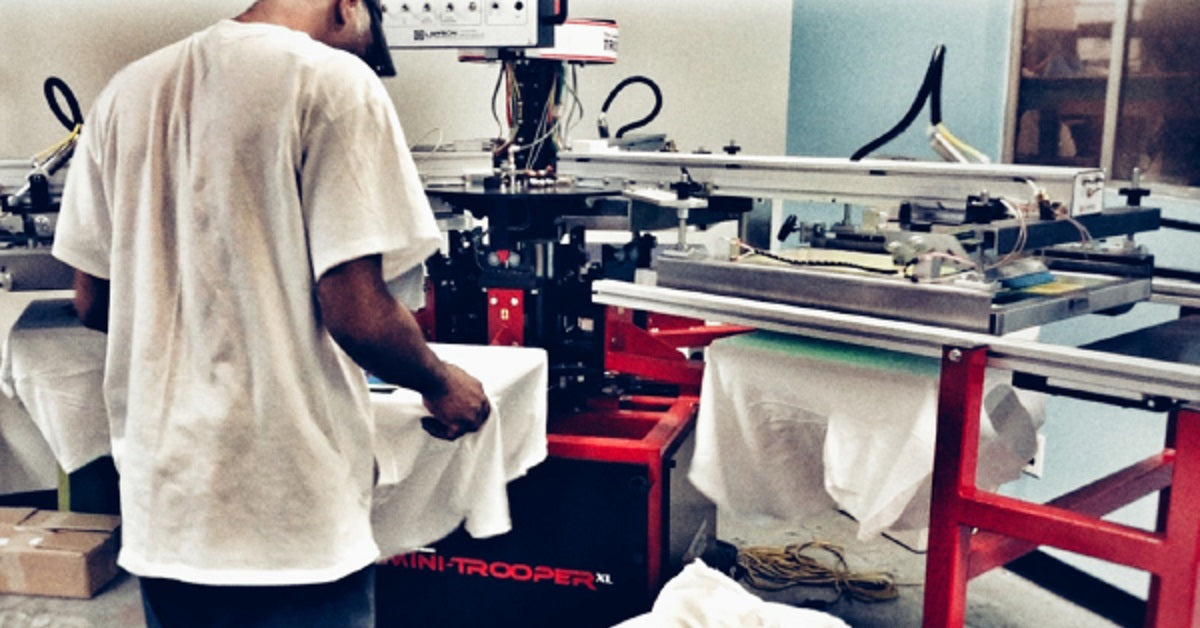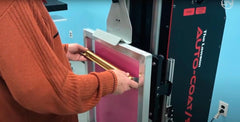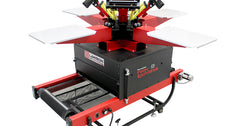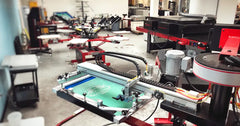After reading this guide you should be able to troubleshoot some of the most common screen printing problems.
Beginner screen printers face a lot of challenges and have a lot of questions about how to fix mistakes that happen when screen printing. Issues include problems like prints washing out, dye-migration/bleeding and spot flash drying are all on-press problems that can be easily overcome. Here is a list of 10 of the most common printing problems beginner screen printers face when screen printing with plastisol ink and how to fix the issue. These quick and easy screen printing solutions will fix these screen printing mistakes and help you achieve a better screen printed image.
1. Problem: your prints are washing away. Your screen printed image is washing away because the ink has not been totally cured.
Solution: There are a few possible solutions to fix this problem. The first is to simply dry your screen prints longer and have them in the conveyor heat chamber for a longer period of time. Two, check to see if your conveyor dryer is reaching the proper temperature with Thermo-Tel heat sensitive tapes. If your dryer is not reaching the proper temperature your ink will never dry. Third, adjust the belt speed and oven temperature to the ink manufacturer’s recommendations. A lot of traditional screen printing inks cure at 320 degrees, which can be a problem. Try using low-cure inks, like Dynamic Ink, that cures at 280 degrees to stop your screen printed images from washing out.
2. Problem: your prints lack opacity. This is referring to when your ink deposit on the shirt does not solidly block out the garment color. Your print may appear dull and weak.
Solution: Make your print more opaque by leaving a thicker ink deposit. You put a thicker deposit of ink on your shirt by either using a lower mesh count, a thicker stencil (more emulsion on the screen), or a larger amount of off contact. Another possible answer is to print a white underbase. An underbase prints helps the color on top look vibrant. You can also do a print, flash, print sequence and put two layers of the same color on top of each other.
3. Problem:you see dye migration occurring. This happens on polyester and certain 50/50 or tri-blend shirts when the dye in the synthetic fabric heats up to the point that it becomes a gas and “migrates” up from the shirt through the ink. Dye migration usually happens around 300 degrees.
Solution: Switch away from standard plastisol and start using a low-cure ink that dries around 280 degrees. Since the problem occurs around 300 degrees and traditional ink cures at 320, you will be constantly fighting dye-migration. However, by using a low cure ink, you can reduce the oven temperature of your conveyor dryer to eliminate the problem. We recommend Dynamic Ink as it is a low-cure ink and has special low-bleed dye inhibitors that prevents bleeding.
4. Problem: your screen prints are peeling away once they are dried. Having printed and dried the shirt, you have a problem if your plastisol ink is peeling around the edges.
Solution: Either the plastisol ink is undercured, or the ink you’re using is not the right kind for the t-shirt you are printing on. Some inks are designed to only be printed on cotton, or polyester. Using them on different fabrics could lead to problems. Make sure the ink works with the garments you are using by reading the manufacturer’s instructions. Also, check if the ink is properly cured as described in question one. A peeling print might mean you did not cure it enough.
5. Problem:you are printing an underbase and your next color won’t stick to the underbase. A white underbase helps make your colors look great but only if it is working properly.
Solution: This problem is caused by over flashing your underbase. Make sure that you are only flashing, not fully curing, your underbase layer. If you fully cure the underbase, your next color will not adhere properly. If you are over flashing, try spot curing for a shorter time, or raise your flash unit higher, or turn the spot dryer heat down. If you touch flashed ink, it should still feel a little wet and slightly tacky.
6. Problem: you are seeing fibrillation coming through your screen printed image. Fibrillation refers to cotton fibers sticking up from the shirt through your screen printed images. This can cause your print to look fuzzy or faded.
Solution: There are a few ways to fix fibrillation. First, try using a thicker layer of ink. More ink will help matt the fibers down. Second, use a higher quality ink. Cheaper plastisol ink has more “filler” components that are not as dense as quality components and can lead to worse fibrillation. Finally, add an underbase. Printing an underbase will add more ink and act as a barrier that keeps any fibers from interfering with your final image.
7. Problem: the final print feels stiffer than you want. This is more of a preference rather than a true “problem”. Some people like the heavier feel, but if you want your screen print to feel lighter there is an answer.
Solution: Use a soft hand extender. This helps lighten up your plastisol ink so your final print is softer. Make sure to follow the manufacturer’s recommended mixing ratio so you do not reduce the vibrancy of your ink.
8. Problem:you are getting ghost images on your shirts. Ghost images on a shirt refer to when the printed image shows through to the other side of your t-shirt.
Solution: If you are seeing a ghost image on your shirt, you are most likely using too cheap of an ink for the shirt you are printing. Ghosting is typically caused by cheap inks that have bleaching agents in them. Use a higher quality ink like Dynamic Ink that is phthalate free and is not made up of lots of “fillers”.
9. Problem:the final print is starting to crack. Nobody will be happy with a print that cracks. This problem typically shows up after the first time a shirt is washed. The biggest cause of this is undercured ink.
Solution: Test your finished prints by stretching the printed area with your thumbs. You do not need to put a lot of muscle into it but give it a little pull. If properly cured, the print will not crack. If it does, cure your shirts for longer as described in number 1.
10. Problem: your shirts are sticking together after drying. This can be a big problem because if your t-shirts are sticking together your screen print might be ruined. This problem tends to happen when you have not given your ink enough time to cool down after drying.
Solution: Give your shirts a little time before packing up or folding and shelving your finished product. If the problem is still happening try putting a fan where your shirts come out of the dryer to speed up the cooling process.
After reading this guide you should be able to troubleshoot some of the most common screen printing problems. Fixing screen printing problems can be done by trial and error. Remember that different shirts react differently, so the solution that worked before may not work again. Be ready to use all the problem-solving solutions. Focusing on solving these 10 mistakes that beginner screen printers make when printing t-shirts will ensure better results.







